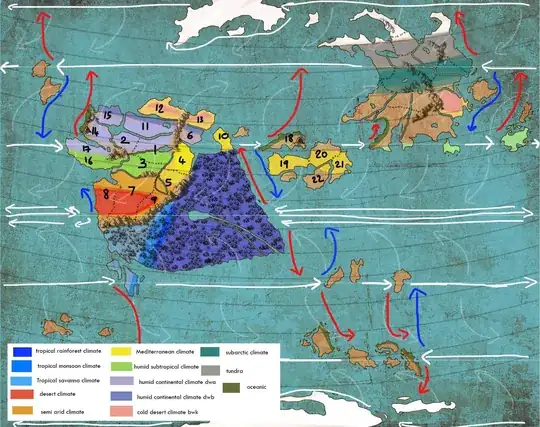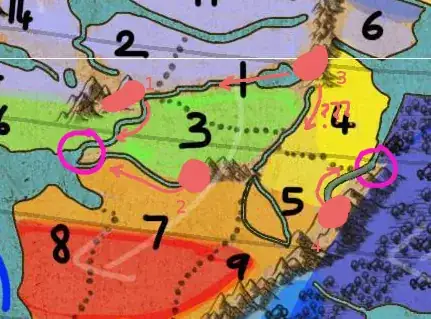Give someone a fish and you feed them for a day...
It shouldn't surprise you that we're not going to tell you what resources to assign to any geographical area or where your trade routes should be. To be honest, that's doing too much of your work for you.
...Teach someone to fish, and you feed them for a lifetime.
On the other hand, I think it's more than reasonable to offer advice for developing resource lists and the nature of what a good trade route would be.
There's a point to be made here before I continue. Whole books... Whole libraries of books... have been written about resources and trade. You need to determine just how complicated you want all this to be. Frankly, I'd start really, really simple and make it more complicated later as you develop your world. You don't want an entire book describing your world's resources and trade. You want a couple of pages of paper. If you're feeling like the process is overwhelming, that means you're trying to reach for a solution that's too complicated. Simplify... Simplify... Simplify... With experience will come the ability to see how to make it more complex (if that's even necessary).
OK, let's continue.
Resources
One of the reasons why we won't tell you what resources could or should be where is that resources depend too much on the details of what you want to do with your world. There are literally millions of resources that are valuable for trade. Where would we start? You, on the other hand, are in a great position to create a list of the resources you want to have in your world. Write them down. If you've listed more than 10-20 items, you're biting off too big a chunk. But nothing's stopping you, but I recommend keeping the list as small as you can in the beginning. For now, I'll use one Terrestrial resource to use as an example.
Grain.
- Using your favorite search engine, discover where grain likes to grow. Obviously it's a bit hard in a desert, but that's good to know because desert dwellers would be willing to trade something to get grain! You'll also discover it's not much of a mountain-side crop. But in the valleys, where there's good irrigation or appropriate (ah, appropriate, you need to do a little research into grain! You might even need to pick just one...) you can grow grain. Armed with this information, you can match grain to your climate zones and geographies.
Let me pause for a moment to mention something. Resources can be raw resources such as agriculture/hunting/husbandry, mining, and lumber/forestry, or it can be manufactured resources like tools, weapons, vehicles... And I'm not even touching on intellectual resources like technology, education, philosophy... Remember what I said about complexity. Start simple! Keep that list short! Once you get a hang of how this all works, it's not hard to make the list longer and more complex.
Next, you need to identify two statistics for each resource: how much is needed (say, per capita, but that's just one of a number of metrics) and what it takes to move it. Not surprisingly, people need a lot of grain! And it's heavy. That means trade routes need to be capable of hauling a lot of grain at once, or they must be capable of hauling smaller amounts frequently.
Finally, you need to identify one more statistic, excess. I call it "excess," but you can measure this statistic in a lot of ways. The point is, how much of the resource is available for trade? A lot? A little? This will matter when it comes to how valuable it is as a trade commodity.
BTW, if you haven't played that ancient but wonderful video game Sid Meier's Railroad Tycoon or one of its many descendants, go find a copy and play it. You can keep resources and trade really simple — or you can complicate the snot out of it. I'd vote for keep it simple, but that's up to you. BTW, I'm repeating myself for a reason....
Trade
Now that you know where your resources are, how much are available, how much is needed for consumption, and how painful it is to move it... let's start making some money!
Trade is a lot like water — it follows the path of least resistance unless there's a compelling reason to take a harder path. Nobody will move grain over the top of a mountain... unless the starving people on the other side are swimming in lumber, which you desperately need! They'll also not move grain to a location that won't pay for it (for whatever reason) no matter how easy it is to transport it.
- For each resource, identify the areas of your world that lack that resource. The more fundamental the resource (like Grain) the more likely it will be needed to some degree by almost everyone. The more rare and/or specific the resource (like jewelry), the less likely anyone will need it.
You can already see how easy it is to make trade really, really, really complicated. Jewelry could be desirable to everyone for one reason or another. But it actually isn't needed by anyone. I strongly recommend that you focus first on necessary or raw resources (e.g., food, building materials, defensive materials, tools...) You can complicate this by creating, for example, a 0-10 scale representing how much an area "lacks" a specific resource where "0" means the area can completely supply its own needs for that resource and "10" means the area is desperate for it. But I'd advocate that you start with a 0-1 scale, or maybe a 0-2 scale and build complexity later. Keep it simple!
Next, for every pair of locations (a source for the resource and a need for the resource), look at your map and determine the path of least resistance to move the resource from A to B. Start with pairs and build chains later. The most viable pair (right now) will always be the closest pair or the pair with the shortest distance or easiest route between them. That's your first trade route!
Next, for each pair you identified in #2, determine if there's a need to return something along the route! A one-way trade route is less valuable than a bi-directional trade route. One-way trade routes are, therefore, less likely to develop unless the value of the trade is higher. Here's where you might erase a short or easy one-way trade route in favor of a longer or harder bi-directional trade route.
Finally, as you start identifying these pairs, start looking for patterns where you can chain a valuable trade item (oh, let's say, spices) along several pair-paths. Congratulations! You've just created your first Silk Road! A "silk road" trade route is a longer, more complex, but highly valuable trade route that spans nations. Such a route may include those short/easy one-way trade routes because they're a bonus when considering the entire road.
Obviously routes can move over the ocean, along rivers or lakes, and over land. Each has its pros and cons (the ocean allows you to move MASSIVE amounts of material... right up until that tsunami hits and sinks all your ships or some pirate privateer comes along and appropriates your cargo. See how complex trade can be? I'm not even going to discuss the consequences of crime on trade routes (a trade route that passes through a dense forest might allow for greater crime compared to a river route...).
So... There are the basics. You can easily see how an entire book can be written about this subject. Regrettably, the ability to write a book as an answer is one of the reasons a question can be closed, which is why all I've done is taught you the rudiments of fishing resources and trade networks. From here on out, if you need more help, you need to identify a specific problem along with why it's a problem and why you can't resolve it. And please keep that book rule in mind! If you're asking a really broad question, your first thought should be, "wait... What can I do to simplify this?" That's always good advice!
Hey Worldbuilders! I have a challenge for you!
A list of games and/or simulators focusing on trade would be a great addition to our Worldbuilding Resources list. I've created a "Trade References, Simulators and/or Games" section. I was tempted to included Sid Meier's Railroad Tycoon as a first entry, but frankly, as useful as it is to see the basics of resources and trade, I think it focuses too much on managing trades to be a good resource for teaching resources and trade. There must be something better! If you know of any references, games or simulators that specifically focus on resources and trade (and I mean "specifically." Don't include your favorite MMORPG or shoot-em-up game just because it includes resources and trade), please go and list it! You'll be doing everyone a favor!










Explaining an example to me in such a simple way is really what I need. Thank you very much. It's very interesting! :D
– Lendellz Mar 24 '22 at 20:27